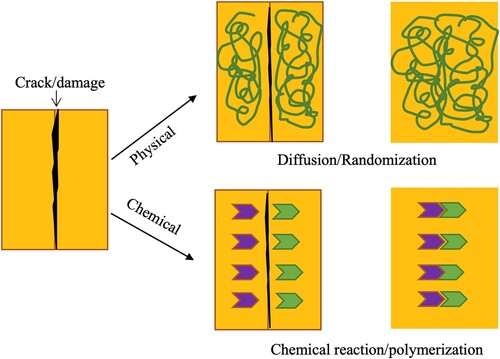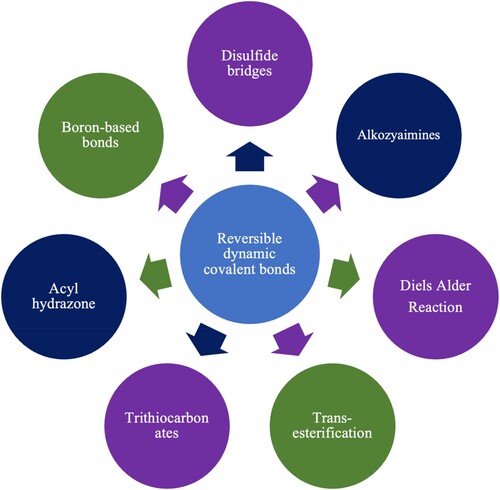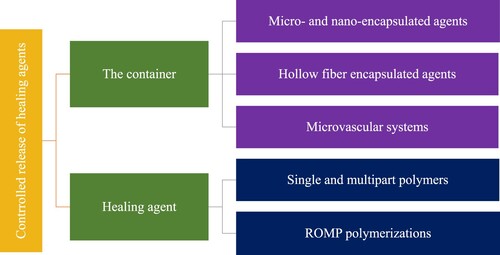Self-healing coatings that mimic nature’s ability to self-repair have become a focus of research for engineers, chemists, and materials scientists. Despite the complexity of biological systems, the transfer of biological insights into technical applications is made possible by the common physical, chemical, and mathematical laws existing in both biology and technology. Developing, defining, and characterizing self-repairing coatings continues to be a challenge for scientists, with questions surrounding whether self-repair is a materials’ property or a function and what standard criteria should be used to quantitatively assess the self-repair effect.
Self-healing coatings are being studied for various substrates – concrete, metals, and polymers. In fact, the use of self-healing technology has been known for centuries in construction materials. As early as the second century AD, the Roman builders used a technique called hot mixing while constructing the Pantheon. This involved using quicklime in addition to, or instead of, slaked lime to create a mortar matrix that retained high surface area aggregate-scale lime clusters. If cracks appeared, water in the form of rain, seawater, or moisture that seeped through the calcium clusters, dissolved them and filled the newly formed cracks [Citation1]. While this was not exactly coating technology, the example goes to show that the idea of self-healing materials is not a new one.
Self-healing coatings are commonly classified based on their mode of self-repair, into physical (e.g. diffusion and randomization) and chemical (e.g. chemical reactions polymerizations, etc.) processes ().
In physical healing, polymers are frequently used. According to a commonly used five-stage self-healing theory reported in 1981, the steps involved in the physical healing process are surface rearrangement, surface approach, wetting, diffusion, and randomization [Citation2]. The restoration of the coating’s integrity is particularly dependent on the diffusion of polymer chains. A recent study utilized a dually crosslinked hydrogel system to decouple complex factors and visually demonstrate polymer diffusion, providing a quantification of healing dynamics. Polymer diffusion across the crack interface was observed, with diffusion speeds ranging from 0.51 to 0.04 μm/s depending on the degree of constraining ().
Figure 2. Fluorescence microscopy of the interface between two hydrogels after rejoining for 0 s, 5 min, and 10 min, respectively. Scale bar: 100 μm. Image reproduced without modification from [Citation3].
![Figure 2. Fluorescence microscopy of the interface between two hydrogels after rejoining for 0 s, 5 min, and 10 min, respectively. Scale bar: 100 μm. Image reproduced without modification from [Citation3].](/cms/asset/ed3afbd1-ce92-4a6d-bbee-ed8a83efadfb/ysue_a_2195772_f0002_oc.jpg)
A study recently showed that Poly(phenylene methylene), which is being explored as a corrosion coating for aluminium and other metals, exhibits self-healing properties through the physical healing effect – the polymer flows in response to a thermal shock, which leads to healing properties [Citation4].
Chemical healing can, in turn, be intrinsic or extrinsic. The intrinsic approach is when self-healing is facilitated by reversible chemical bonds within the polymer material (). This allows for the coating to be restored after damage by the application of external stimuli like heat, ultraviolet light, or other initiator chemicals [Citation5]. Self-healing networks possess inherent properties that enable crosslinks to migrate along polymer chains without compromising structural integrity or other properties.
Extrinsic self-healing involves the specific addition of healing agents to the coating. The most common extrinsic approach has been to encapsulate healing agents in various micron- or nanosized containers that break during damage to release chemicals that induce healing ().
Capsules can be easily integrated into polymer systems, but the drawback of this is that the healing agent is depleted after a single damage event. Designing microcapsule-based self-healing materials requires designing the microcapsules and incorporating them into polymer matrices [Citation6], studying the trigger that breaks the capsule and releases the agent, and determining the extent of self-healing reactions and the ability to ensure that the properties remain acceptable for service. Suitable encapsulation methods must consider parameters like solubility, reactivity, viscosity, and volatility of the capsule materials. Microcapsules made of urea-formaldehyde, melamine-urea-formaldehyde, and polyurethane are extensively studied because they can withstand processing conditions in thermoset resins and composite materials [Citation7]. There have been studies on encapsulating the healing agents inside hollow fibres for the same purpose – the fibres in many cases serve the dual purposes of self-repair and interfacial toughening [Citation8]. These hollow fibres are most commonly fabricated by electrospinning methods.
Microvascular-based self-healing coatings are probably the closest to biomimetic systems () and offer a solution to the limitations of capsule-based healing systems, where a finite supply of healing agents restricts the number of possible healing events.
The containers, which can be in the form of capsules, hollow tubes, or vasculatures, can be composed of either organic/inorganic polymers or porous inorganic materials. Inorganic materials like mesoporous silica, titania, ion-exchange nanoclays, and halloysite nanotubes, are often utilized as inorganic containers for self-healing coatings. Despite being available in large commercial quantities, mesoporous silica, and titania are comparatively more expensive than raw materials like ion-exchange clays and halloysites ( and ).
Figure 5. The biomimetic approach of microvascular self-healing. Image reproduced without modification from [Citation9].
![Figure 5. The biomimetic approach of microvascular self-healing. Image reproduced without modification from [Citation9].](/cms/asset/d16ef3e3-febf-4d63-b52b-0a6477aa13f5/ysue_a_2195772_f0005_oc.jpg)
While the capsule, hollow tube, and vasculature are the container that breaks to release the healing agent, the agent in itself causes the healing action through chemical reactions and polymerization reactions. Some commonly used single-part healing agents are shown in
Table 1. Some common healing agents and healing mechanisms [Citation10].
In two-part healing, the two parts (usually the polymeric precursor and the catalyst) are either separately encapsulated and brought together in case of damage, or one component is encapsulated and the other component is dispersed in the matrix [Citation11]. The ring opening metathesis polymerization (ROMP) of dicyclopentadiene (DCPD) using Grubbs’ catalyst is an interesting two-part system that has been extensively studied for use in self-healing coatings. This chemistry is highly effective because of multiple reasons – DCPD is an affordable monomer, it remains in a liquid state at room temperature which allows it to flow smoothly out of microcapsules, and has low volatility, which allows it to remain in the crack and polymerize before evaporating. Additionally, DCPD has a long shelf life due in part to its relative resistance to radical polymerization
A typical way in which ROMP is used for self-healing is that the diene (DCPD) is placed in the capsule and the catalyst is outside the capsule. When the capsule breaks, the DCPD comes in contact with the catalyst and the polymerization proceeds, sealing the damage ().
Figure 7. A schematic of the use of encapsulated DCPD (represented as globules) and catalyst (represented as black dots) in self-healing. Image reproduced with minor modifications from [Citation12].
![Figure 7. A schematic of the use of encapsulated DCPD (represented as globules) and catalyst (represented as black dots) in self-healing. Image reproduced with minor modifications from [Citation12].](/cms/asset/4d35f91c-db66-452b-b690-df9f032bc7d6/ysue_a_2195772_f0007_oc.jpg)
Other methods that have been studied for self-healing coatings include the electrodynamics method (where physical damage changes the electrical properties of the coating, which instigates a ‘blood clot’ type repair mechanism [Citation13]), the magnetodynamic method (magnetically active materials manipulated through the application of magnetic fields to induce repair [Citation14]), light-induced self-healing [Citation15], shape-memory enhanced self-healing [Citation16], etc.
There have been out-of-box ideas that are simple, and yet ingenious. Researchers at the University of Hertfordshire, for example, have developed a limewash coating for building surfaces, which employs bacteria to create a protective shield against erosion damage. The limewash incorporates non-pathogenic bacteria that enhance the amount of CO2 the building surface can absorb via photosynthesis. This results in the production of more calcium carbonate, which in turn creates a stronger barrier against erosion and promotes self-repairing mechanisms [Citation17]. The use of bacteria to self-heal concrete structures (), however, is not new and there have been many studies in the past decade that have studied various aspects of it.
Figure 8. Crack healing in concrete by Bacillus cohnii. Image reproduced without modification from [Citation18].
![Figure 8. Crack healing in concrete by Bacillus cohnii. Image reproduced without modification from [Citation18].](/cms/asset/25844223-5f15-4b9d-89d0-13f6ba72fe5b/ysue_a_2195772_f0008_oc.jpg)
Perhaps the most exciting development in recent years, especially for those of us who are habitual mobile phone droppers, is the self-healing coating that has been developed by scientists at the Korea Institute of Science and Technology that auto-repairs broken smartphone screens [Citation19]. The scientists have developed microcapsules containing linseed oil mixed with silicone to create a protective coating on transparent polyimide screens used as screen guards. In the event of a screen crack, the microcapsules burst, flow to the broken area, and repair the damage.
Self-healing coatings are a fertile field for research and can potentially revolutionize various industries, from aerospace to electronics, by reducing the need for frequent repairs and replacements. These materials can autonomously repair damage caused by wear and tear, cracks, and other types of damage, thereby increasing the lifespan of products and reducing costs. While still in the early stages of development, self-healing materials hold great promise for the future, and ongoing research and innovation will continue to push the boundaries of what’s possible.
References
- Seymour LM, Maragh J, Sabatini P, et al. Hot mixing: mechanistic insights into the durability of ancient Roman concrete. Sci Adv. Jan. 2023;9(1):eadd1602, 13p. doi: 10.1126/sciadv.add1602.
- Wool RP, O’Connor KM. A theory crack healing in polymers. J Appl Phys. Oct. 1981;52(10):5953–5963. doi: 10.1063/1.328526.
- Hai M, Zhang Q, Li Z, et al. Visualizing polymer diffusion in hydrogel self-healing. Supramol Mater. Dec. 2022;1:100009, 6p. doi: 10.1016/j.supmat.2022.100009.
- D’Elia MF, Magni M, Romanò T, et al. Smart anticorrosion coatings based on poly(phenylene methylene): an assessment of the intrinsic self-healing behavior of the copolymer. Polymers (Basel). Aug. 2022;14(17):3457, 13p. doi: 10.3390/polym14173457.
- Nik Md Noordin Kahar NNF, et al. The versatility of polymeric materials as self-healing agents for various types of applications: a review. Polymers (Basel). Apr. 2021;13(8):1194, 34p. doi: 10.3390/polym13081194.
- Song J, et al. Self-healing conversion coating with gelatin–chitosan microcapsules containing inhibitor on AZ91D alloy. Surface Eng. Jan. 2018;34(1):79–84. doi: 10.1080/02670844.2017.1327187.
- Neon Gan S, Shahabudin N. Applications of microcapsules in self-healing polymeric materials, in Microencapsulation – processes, technologies and industrial applications, IntechOpen, 2019. doi: 10.5772/intechopen.83475.
- Seyyed Monfared Zanjani J, Saner Okan B, Yilmaz C, et al. Monitoring the interface and bulk self-healing capability of tri-axial electrospun fibers in glass fiber reinforced epoxy composites. Compos Part A Appl Sci Manuf. Aug. 2017;99:221–232. doi: 10.1016/j.compositesa.2017.04.017.
- Toohey KS, Sottos NR, Lewis JA, et al. Self-healing materials with microvascular networks. Nat Mater. Aug. 2007;6(8):581–585. doi: 10.1038/nmat1934.
- Xue C, Li W, Li J, et al. A review study on encapsulation-based self-healing for cementitious materials. Struct Conc. Feb. 2019;20(1):198–212. doi: 10.1002/suco.201800177.
- Liao LP, Zhang W, Zhao Y. Preparation and healing property evaluation of self-repairing polymer coating. Surf Eng. Feb. 2014;30(2):138–141. doi: 10.1179/1743294413Y.0000000216.
- Romero-Sabat G, et al. Development of a highly efficient extrinsic and autonomous self-healing polymeric system at low and ultra-low temperatures for high-performance applications. Compos Part A Appl Sci Manuf. Jun. 2021;145:106335, 13p. doi: 10.1016/j.compositesa.2021.106335.
- Trau M, Saville DA, Aksay IA. Assembly of colloidal crystals at electrode interfaces. Langmuir. Nov. 1997;13(24):6375–6381. doi: 10.1021/la970568u.
- Cerdan K, Moya C, Van Puyvelde P, et al. Magnetic self-healing composites: synthesis and applications. Molecules. Jun. 2022;27(12):3796, 28p. doi: 10.3390/molecules27123796.
- Ji S, Cao W, Yu Y, et al. Visible-light-induced self-healing diselenide-containing polyurethane elastomer. Adv Mater. Dec. 2015;27(47):7740–7745. doi: 10.1002/adma.201503661.
- Selezneva EV, et al. How shape memory effects can contribute to improved self-healing properties in polymer materials. Macromolecules. Mar. 2021;54(5):2506–2517. doi: 10.1021/acs.macromol.0c02102.
- University of Hertfordshire. Herts researchers develop building coating that uses bacteria to protect and self-repair against erosion; 2023.
- Kumar Jogi P, Vara Lakshmi TVS. Self healing concrete based on different bacteria: a review. Mater Today Proc. 2021;43:1246–1252. doi: 10.1016/j.matpr.2020.08.765.
- WATCH: New ‘self-healing’ phone screens can fix cracks within 20 minutes. https://www.geo.tv/latest/326934-watch-new-self-healing-phone-screens-can-fix-cracks-within-20-minutes.




